| 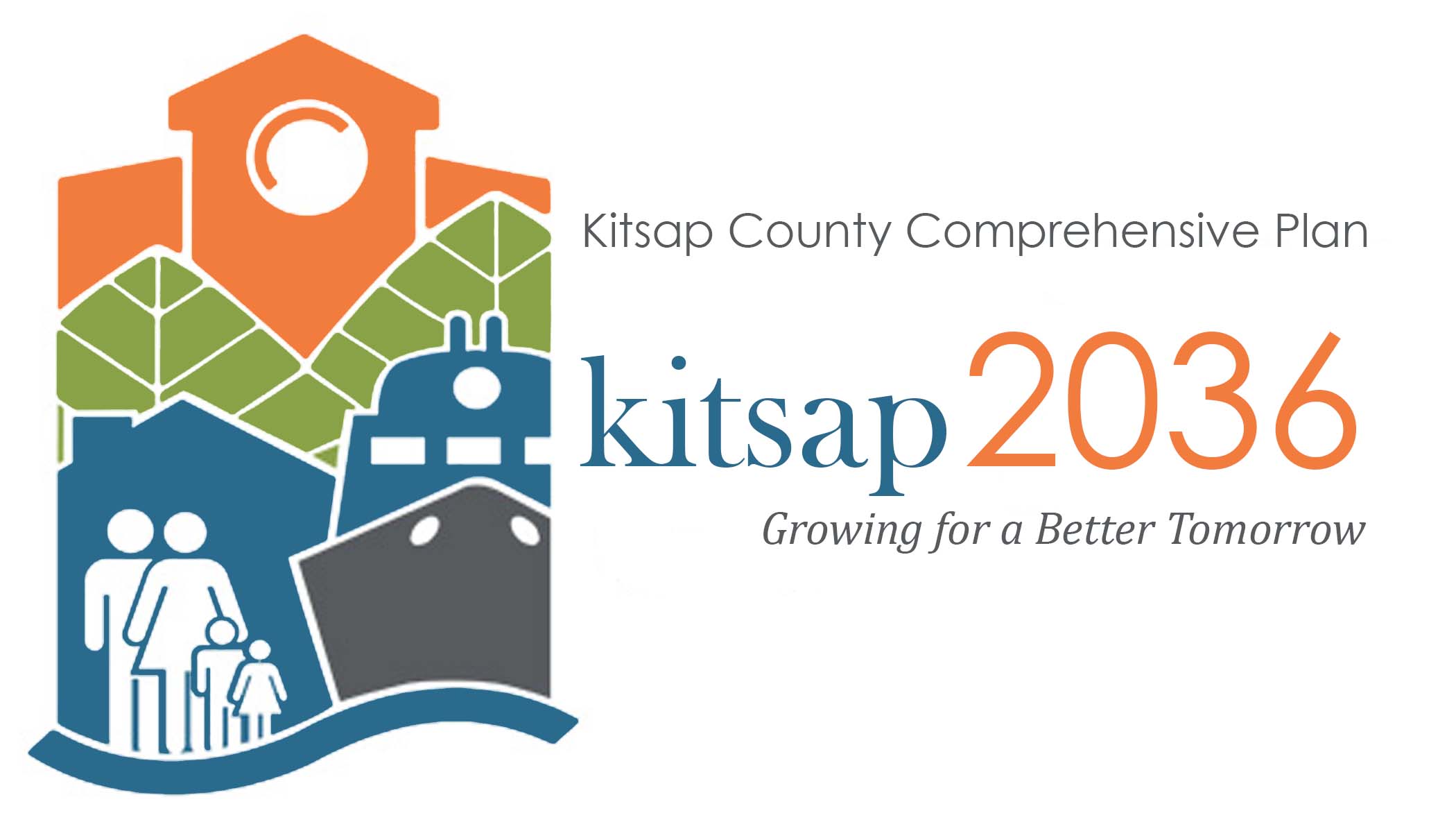
|

WHAT IS THE COMPREHENSIVE PLAN?
A Comprehensive Plan (plan) is a 20-year blueprint for local policy, planning and capital facility investment. This plan is used as a guide for local governments through the establishment of vision statements, goals, objectives, policies, and implementing actions. This framework is intended to guide the day-to-day decisions of elected officials and local government staff.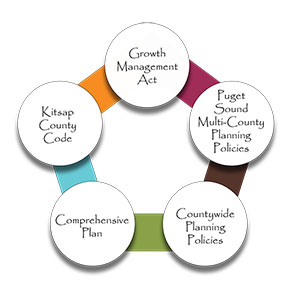
The Washington State Growth Management Act (GMA), 36.70A Revised Code of Washington (RCW) requires Kitsap County to enact a comprehensive plan for unincorporated Kitsap County. The GMA requires the Comprehensive Plan to include mandatory elements while other optional elements may be included based on local circumstances. The cities located within Kitsap County such as Bainbridge Island, Poulsbo, Bremerton and Port Orchard also develop their own comprehensive plans for their incorporated municipalities. These local comprehensive plans are guided by GMA, applicable multi-county planning policies established by the Regional Planning for a Sustainable Future | Puget Sound Regional Council (psrc.org), and countywide planning policies such as those developed by the Kitsap Regional Coordinating Council - Land Use Planning (KRCC).
Kitsap County adopted its first GMA compliant comprehensive plan in February 1999.

Mandatory updates past and future
The comprehensive plan include a 20-year planning horizon and mandatory periodic updates are required by the Growth Management Act (GMA)
every 10 years.
Between mandatory updates, the County may choose to consider minor amendments to the plan on an annual basis. Other amendments, such as to resolve an appeal, can be processed at any time.
Previous mandatory periodic updates, can be viewed on the
Past Comprehensive Plans webpage.
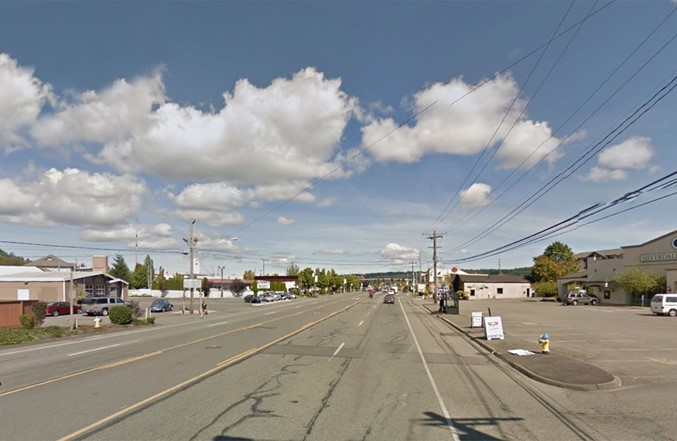
| 
|

What is the Comprehensive Plan? (Story map)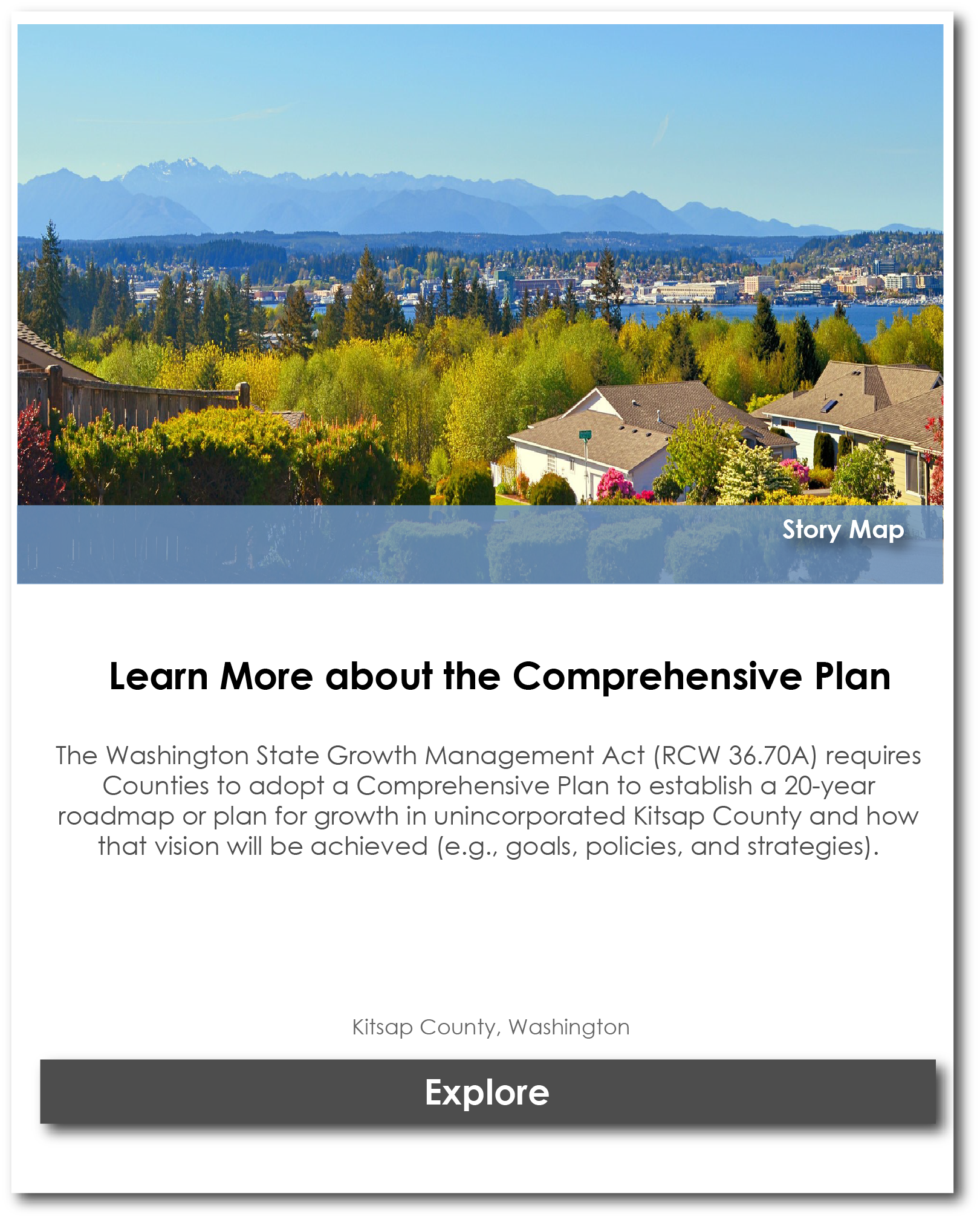
| What is Zoning? (Story map)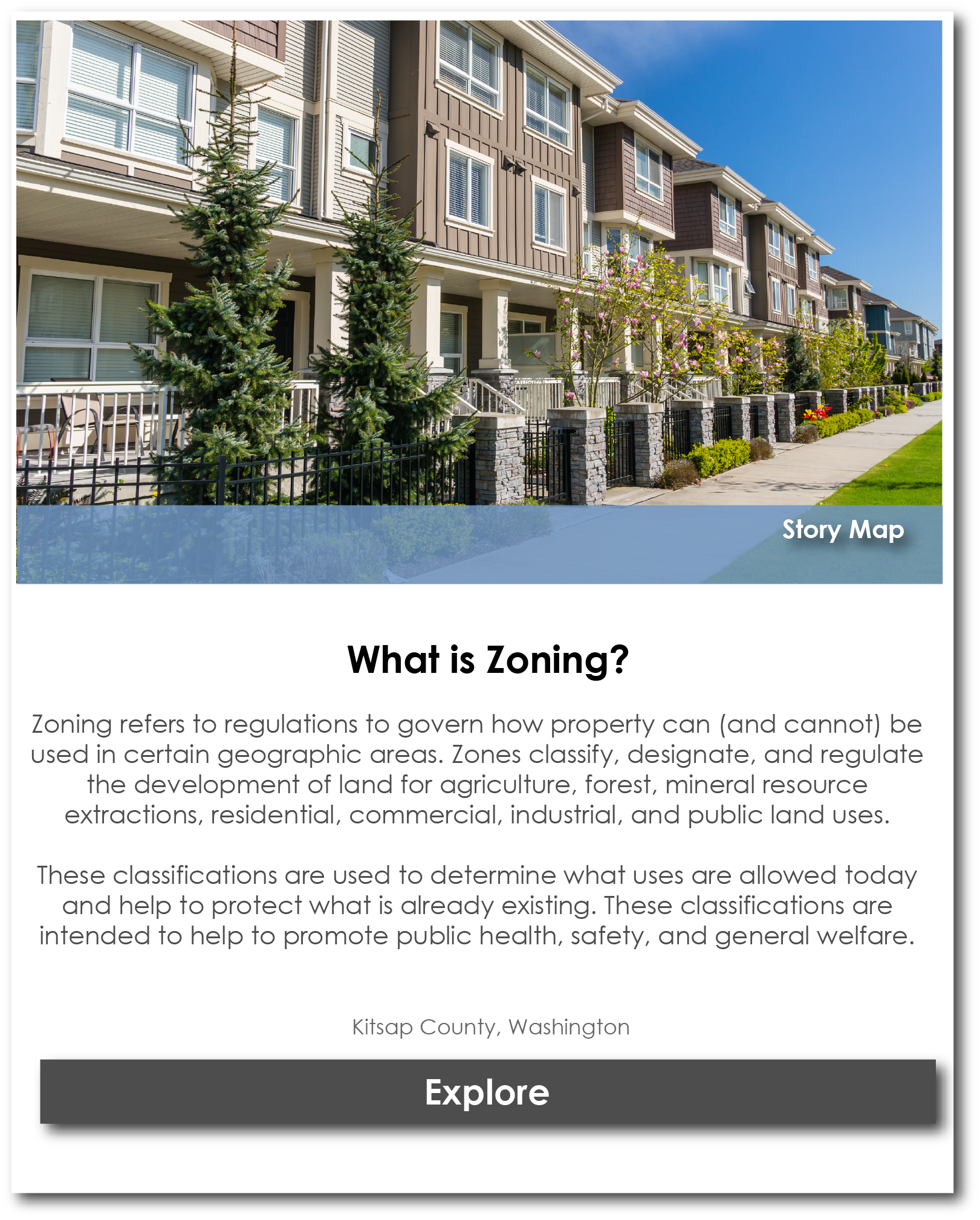
|
THE GROWTH MANAGEMENT ACT
In the 1990s, the Washington State legislature enacted the Growth Management Act (GMA),
36.70A Revised Code of Washington (RCW). The purpose of this state mandate was to address concerns over unplanned and uncoordinated growth that led to sprawl or suburban-type development, loss of farmland, natural resource degradation and uncoordinated capital facilities development.
The GMA is also governed by several
Washington Administrative Codes (WAC) and case-law interpretations since its enactment. Please visit the
Washington State Department of Commerce and
Hearings Board webpages for more information.

The GMA outlines 14 planning goals, mandatory requirements and deadlines for periodic updates. Under GMA, Kitsap County and the cities within must plan fully under the GMA. This state mandate also sets expectations with growth for urban, rural and resource lands.
Mandatory Comp Plan Elements.
The GMA requires certain elements to be included in the Kitsap County Comprehensive Plan. Per
RCW 36.70A.070, these include: -
Land Use.
-
Housing.
-
Capital Facilities Plan.
-
Utilities.
-
Economic Development.
-
Parks and Recreation. *
-
Rural Lands (counties only).
-
Transportation.
-
Economic Development. *
* Per RCW 36.70A.070(9), these elements are listed as mandatory in RCW 36.70A.070(7) and (8), but it is the intent that new or amended elements required after January 1, 2002, be adopted concurrent with the scheduled update provided in RCW 36.70A.130. Requirements to incorporate any such new or amended elements shall be null and void until funds sufficient to cover applicable local government costs are appropriated and distributed by the state at least two years before local government must update comprehensive plans as required in RCW 36.70A.130. |
Optional Comp Plan Elements.
-
Environment.*
-
Conservation(RCW 36.70A.080).
-
Solar Energy(RCW 36.70A.080).
-
Recreation (RCW 36.70A.080).
-
Subarea Plans(neighborhoods, rural villages, urban growth areas, tribal areas, etc.).*
-
Ports(optional for cities with annual maritime port revenues of $20 million to $60 million, RCW 36.70A.085).
* Included in the 2016 Kitsap County Comprehensive Plan.
|
Subarea Plans (Optional Comprehensive Plan Element)
Kitsap County has several
community and subarea plans. These community specific plans allow focused goals and policies for how a community will grow in a way that creates a distinctive sense of place.
Sub-area plans can also have tailored zoning designations and development regulations within a community.
HOW DOES THE COMPREHENSIVE PLAN AFFECT ME - IMPLEMENTATION?
A comprehensive plan is the framework in which it guides growth over a 20-year planning horizon while balancing the GMAs 14 planning goals and related provisions. Updates and amendments to this Plan include an early and continues public participation plan where communities, associations and interest groups can learn more, participate and provide comments at key stages of the process.

Please sign-up for email or text message updates through the Kitsap County GovDelivery notification system by clicking
here.
THE PLAN DETERMINES THE LAND USE AND ZONING DESIGNATIONS IN KITSAP COUNTY
The Kitsap Comprehensive Plan assigns land use and zoning designations for every parcel within unincorporated Kitsap County. Land use designations provide sideboards on the use of land whether for residential, commercial, industrial, recreational or institutional purposes.
Zoning establishes where a building can be located on a property, how tall a building can be, or how many homes are allowed based on the size of the property. 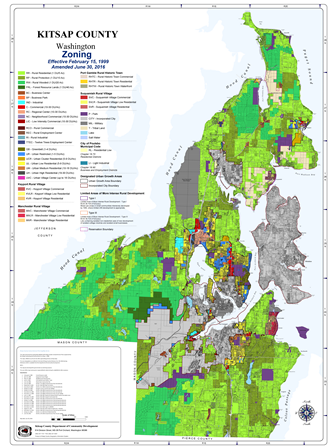
You can determine the land use and zoning for a parcel by visiting the
Community Development Maps webpage or using the interactive
Parcel Search.
THE PLAN GUIDES THE DEVELOPMENT OF KITSAP COUNTY CODE
Kitsap County Codes include regulations adopted by Kitsap County what and how a parcel can be used or developed. These codified requirements go through a legislative process for approval with the final decision rendered by the Kitsap County Board of Commissioners. Many of these codified titles relate to growth and development requirements that implement the vision, goals and policies of Kitsap County Comprehensive Plan, Capital Facilities Plan and the Kitsap Countywide Planning Policies.
In addition to the
Growth Management Act (GMA), other state laws such as the Shoreline Management Act (SMA) requires Kitsap County to update development codes periodically. Additionally, development codes must be updated to remain consistent with changes to federal and state laws such as building and fire codes (Kitsap County Code Title 14), flood hazard regulations (Kitsap County Code Title 15) as it pertains to the Federal FEMA flood insurance program, or
Kitsap County Code Title 12 and the associated
Stormwater Design Manual for compliance with the
Federal Clean Water Act and the Washington State National Pollutant Discharge Elimination System (NPDES) permit.
Please visit the
Kitsap County Code Updates webpage to learn more about current development code update projects and past update projects. This website has a link where you can suggest a code amendment and/or view suggested code revisions received by Kitsap County.

HOW DOES THE COMPREHENSIVE PLAN CHANGE?
The GMA requires periodic updates every ten years. These mandatory updates and the associated schedule are established in RCW
36.70A.130. In addition, GMA allows local jurisdictions to consider annual comprehensive plan amendments no more than once per year, with some exceptions (RCW
36.70A.130(2)).
The County can revise its Comprehensive Plan text (e.g., vision, goals, policies, or strategies) or land use maps through a periodic update or through annual amendments that is guided by Kitsap County Code Title 21, Kitsap County Code Chapter 21.08.
For annual amendments to the Kitsap County Comprehensive Plan, the Kitsap County Board of Commissioners must establish an annual docket that includes the types of amendments that will be considered. These could include site specific amendments, text amendments, area-wide amendments and/or map corrections. This annual docket, set forth via a resolution, establishes the comprehensive plan work plan for that given calendar year. If not included in the annual docket, the comprehensive plan amendment will not be considered.
WHAT IS A REZONE AND A SITE-SPECIFIC AMENDMENT?
WHAT IS A RE-ZONE?
A rezone changes the zoning classification of a parcel but does not require an amendment to the Kitsap County Comprehensive Plan. For example, a property that has an Urban Low Residential Comprehensive Plan designation and zoning classification of Urban Restricted but would like to change its zoning to Urban Low Residential. In this example, both the Urban Low Residential and Urban Restricted zoning classifications share the same County Comprehensive Plan designation. Therefore, this proposal does not require a change to the Plan.
Rezone applications can be submitted at any time and review is guided by Kitsap County Code Title 21, Chapter 21.04.230.
WHY REQUEST A RE-ZONE?
Rezoning a parcel can also change the allowed uses for the property, design requirements, and intensity of development. More specifically, a rezone could change the following, but not limited to:
-
Allowed uses on a parcel (e.g., single family dwelling unit vs. a multiple family dwelling unit). Please view Kitsap County Code Title 17,Chapter 17.410: Allowed Uses for more detailed information about uses allowed in a zone and the permit required to establish that use; or
-
Increase or decrease density, dimension, and design standards. Please view Kitsap County Code Title 17 Chapter 17.420: Density, Dimension, and Design for more detailed information regarding density and design criteria for each zone.
WHAT IS A SITE-SPECIFIC AMENDMENT?
Unlike a rezone request, a site-specific amendment does require a change to the Comprehensive Plan land use designation. For example, a property has Rural Residential Comprehensive Plan designation and Rural Residential zoning, but would like to consider urban level development.
WHY REQUEST A SITE-SPECIFIC AMENDMENT?
A site-specific amendment can change land uses allowed on a parcel (e.g., residential, commercial, industrial, recreational, and institutional). Please view Kitsap County Code Title 17, Chapter 17.410: Allowed Uses for more detailed information about uses allowed in a zone and the permit required to establish that use. A site-specific amendment can also:
- Changes the allowed use on a parcel (e.g., single family dwelling unit vs. a multiple family dwelling unit); Please view Kitsap County Code Title 17, Chapter 17.410: Allowed Uses for more detailed information about uses allowed in a zone and the permit required to establish that use or.
- Increase or decrease the setback requirements of where buildings can be placed on a parcel, height restrictions, and number of dwelling units allowed per acre. Please view Kitsap County Code Title 17 Chapter 17.420: Density, Dimension, and Design for more detailed information regarding density and design criteria for each zone.
THE PROCESS TO CHANGE THE LAND USE OR ZONING
The process to change the land use or zoning of a property depends on whether it requires a change to the zoning map, land use map, or both.
Please review section Kitsap County Code Title 17, Chapter
17.120.010 'Classification of zones' to determine if a rezone will change the Comprehensive Plan land use designation.
Use these forms to help you determine if your request is a Site Specific Amendment or a Rezone:
If you have questions, please reach out to Kitsap1 at
help@kitsap1.com or other available staff opportunities to discuss with DCD staff at compplan@co.kitsap.wa.us or one of the contact methods available on the
Kitsap County Contact page.

